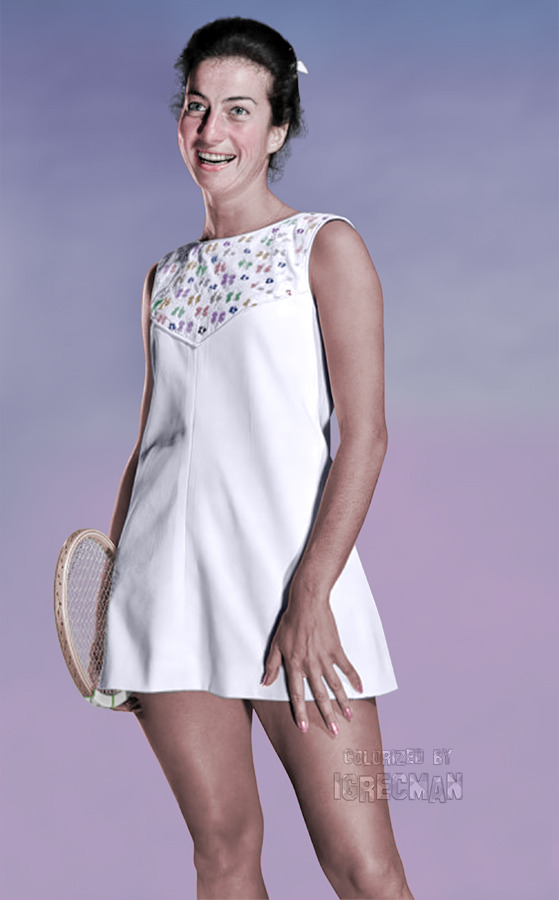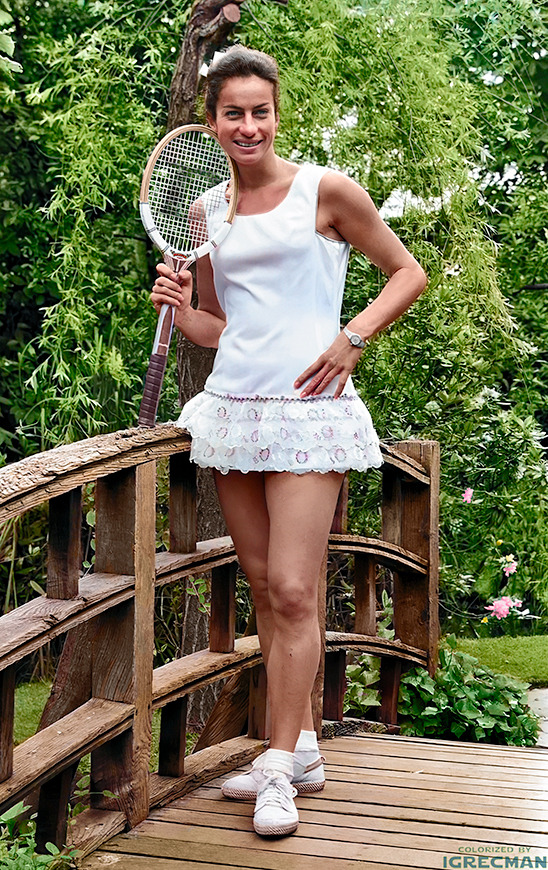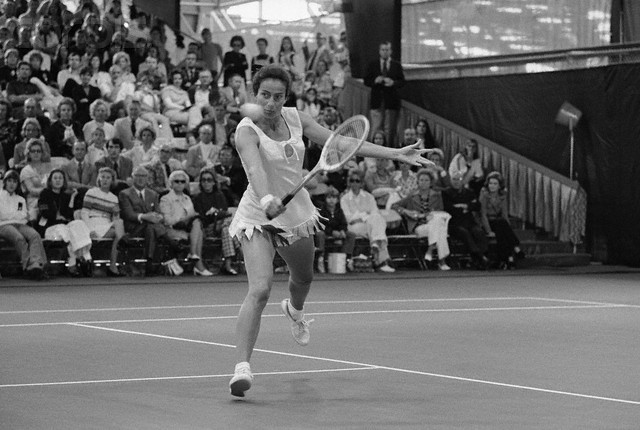In 2022, I’m counting down the 128 best players of the last century. With luck, we’ll get to #1 in December. Enjoy!
* * *
Virginia Wade [GBR]Born: 10 July 1945
Career: 1962-85
Plays: Right-handed (one-handed backhand)
Peak rank: 2 (1975)
Peak Elo rating: 2,285 (2nd place, 1976)
Major singles titles: 3
Total singles titles: 78
* * *
A strange aspect of women’s tennis in the amateur years, and even the first decade of the professional era, is that coaching was virtually nonexistent. There was certainly nothing like what we expect to see today. Most players took lessons as children or teenagers, and some had fathers or brothers who helped them, occasionally even joining them on tour. With rare exceptions, like Eleanor “Teach” Tennant with Alice Marble and Maureen Connolly, there were no traveling coaches.
Maybe we shouldn’t be surprised that Marble and Connolly won so many slams.
Virginia Wade later explained how coaching worked for most of the players on the circuit. You’d try to find an acknowledged expert–someone like Richard “Pancho” González–and get him to spend a few minutes with you. You’d hit a few serves, he’d pass judgment, and that was that.
Somehow, that sort of one-off advice helped Wade win her first big title. Heading into the 1968 US Open, she hadn’t won a title in nine tries, since taking the first Open-era professional trophy in Bournemouth back in April. After losing to Maria Bueno at the US Amateur Championships in Boston in a three-set semi-final, she sought some advice.
González wasn’t on hand, but Doris Hart was. The American had won six singles majors between 1949 and 1955, and in her day, her serve had been as feared as Wade’s was more than a decade later. There was no dedicated training block–Virginia merely sought out the former great for a conversation. On the strength of Hart’s advice, Wade believed she started making 30 percent more of her first serves.
Whatever Hart charged for her time, it should’ve been more. Wade went to Forest Hills and simply overwhelmed the field. She averaged only 40 minutes per match, and after knocking out Rosie Casals in the round of 16, she beat the top three seeds in succession. She finished the job with a 6-4, 6-2 dismantling of Billie Jean King, who had beaten her in nine of their ten previous meetings. She had turned down the prize money to retain her amateur status at Bournemouth, but she happily accepted $6,000 for her efforts in New York.

Colorization credit: Women’s Tennis Colorizations
The press had long called her “imperious,” but before 1968, they were usually referring to her bearing–and it wasn’t always a compliment. Finally, the service motion that many pundits considered to be the best in the women’s game paid dividends. Her results–at least for those two weeks–were every bit as imperious as her manner.
* * *
Wade could’ve used some of Hart’s advice at Wimbledon. From 1968 to 1971, she lost at her home major to Christina Sandberg, Pat Walken, Cece Martinez, and Judy Tegart–none of them seeds, and none of the matches later than the fourth round. She remained one of the prime British hopes at the tournament, but her early exits became a running joke. Headline writers liked both “Ginny Flops” and “Ginny Fizzes.”
The results steadily improved–Wade reached the quarters for eight years running starting in 1972–but it took another round of external help to push her over the finish line.
Ginny was initially reluctant to join up with World Team Tennis (WTT), the upstart American league that paid guaranteed salaries to top players and put on carnival-like exhibitions around the country from 1974 to 1978. When she gave in, she eventually found herself a teammate of Billie Jean King on the New York Sets (later the New York Apples).
The 1976 WTT campaign was, as it turned out, some of the best training Wade could’ve asked for. King told her that you start preparing for Wimbledon the day the previous Wimbledon is finished. Playing for the Apples meant daily practice with male hitting partners and coach Fred Stolle, not to mention near-nightly matches in a newfangled format designed to keep the crowd involved and the tension level high. King would write, “[P]layers had the sensation of being on center court every night.”
Won over to the benefits of regular coaching, Wade assembled a brain trust consisting of Americans Hamilton Richardson–a longtime top-tenner and 1958 US doubles champ–and Jerry Teeguarden, who had previously worked with Margaret Court. In 1977, Teeguarden traveled with her for three months before Wimbledon. The two men helped her rebuild the serve which–while imposing–was once again failing to get the results Wade felt it should. The new delivery was less fluid but more technically correct.
It worked. At Wimbledon, she played the best match of her career in the semi-final against Chris Evert. A few years earlier, Evert had told the journalist Grace Lichtenstein that Wade’s serve was so strong that, “[I]n the first couple of games … [I] had to fight the urge to duck.” Yet Chrissie usually handled the onslaught just fine, and Ginny had won only 5 of their 24 encounters. The top-seeded American had an off-day and Wade kept her nerves in check, winning 6-2, 4-6, 6-1.
She turned in another confident performance to win the title two days later. Against surprise finalist Betty Stöve and in front of the Queen, her self-assurance was so solid that it didn’t waver even after Stöve took the first set. She had come back from match point down against the Dutchwoman twice in 1976, and she knew if it came to that, she could do it again. Stöve was known for her streakiness, and Wade turned the tide, serving so well that one-third of her first offerings didn’t make it back. In her 16th appearance at Wimbledon, Ginny finally won the title, 4-6, 6-3, 6-1.
* * *
There’s a lot to learn by viewing Virginia Wade’s two biggest titles through the lens of coaching. My intent isn’t to take away any of Ginny’s credit for her wins–after all, by modern standards, she barely had any coaching at all. She won 78 career titles in a 17-year-span, most of them with no more than a friend or doubles partner in her corner.
Indirectly, Wade’s peaks shed some light on the media coverage she (incessantly) received. Even if your only reference point is the press hyperventilation over Tim Henman or Johanna Konta, you probably understand how the British media treated their country’s underperforming greatest hope. Ginny noticed, and she lampooned the newspapermen in her 1978 book, Courting Triumph:
My results fluctuated like a yo-yo. There was always a story for the press who loved every see-sawing minute. There was scarcely a report that didn”t mention the word “temperamental”. Sometimes I had “ice-blue eyes”, sometimes “blazing”. Most commonly I was “tempestuous”, “explosive”, “unpredictable”, “arrogant”, “sultry”, “scowling”, “glowering”.
While losing the first set of the 1977 Wimbledon final:
I could just hear some dippy reporter from an obscure tennis biannual calling me a wounded lioness while the others sat in conclave over the riddle of my atavism.
Presumably Wade remains the only Wimbledon champion to have considered the riddle of her atavism before coming back to win a final.
(I had to read this one with a dictionary close by. Thanks to Virginia and her co-author and partner Marylou Mellace, I can now define morphetic and contraviety, as well.)

Colorization credit: Women’s Tennis Colorizations
Certainly, Ginny suffered some losses that she shouldn’t have. The pressure of entering Wimbledon as a home favorite got to her, and it didn’t get easier over time. But with their focus on the “temperamental” star, journalists rarely considered that Wade simply wasn’t yet good enough. It’s a mistake that pundits have made over and over again for decades. Yeah, Nick Kyrgios may be a headcase, but he also has one of the weakest returns in the game.
* * *
The Wade narrative began long before she had any real chance to contend for a Wimbledon title. She qualified for her first appearance at the Championships in 1962, a month before her 17th birthday. She spent the next four years at Sussex University studying mathematics and physics, sometimes finishing her final exams the day before she was due at the All-England Club.
Billie Jean spent 50 weeks of the year preparing for Wimbledon, and she won the first of her six titles there in 1966. Ginny got 24 hours.
When Wade became a regular on tour, the news coverage fed a vicious circle:
Once my ‘temperament’ was latched onto, I became so conscious of my behaviour I’d be unable to think properly during a match. If I missed an easy shot I’d get furious, then waste time trying to control my anger and miss another easy shot. Getting mad made me feel guilty, and suppressing myself scuttled my involvement in the match.
With the benefit of hindsight, Ginny would divide her career into two phases. The first ran through her defeat in the 1974 Wimbledon semi-finals to Olga Morozova–yet another match she should’ve won. The second comprised two of her best seasons–in 1975 and 1976–along with the Wimbledon title in 1977. She refused to accept that her early struggles were due to temperament–she called that “rubbish”–but instead saw two “tennis lives” separated by her perfectionism.
The first Virginia was the one who said, “I would rather play beautiful tennis than win.” Onlookers saw her outbursts and assumed she was spoiled; she thought the flashes of temper stemmed from perfectionism. When everything clicked, as it did at the 1968 US Open, she could play beautiful tennis and win.
Preparing to serve in 1975
But that was never sustainable. Wade eventually learned to play high-percentage tennis, to accept a serve that was less fluid but more effective, and to save her energy for the ball. King told her, “You never have time on the court to waste getting mad,” and in her 30s, Ginny finally learned that lesson.
Wade may have been unlucky to play in an era with such limited coaching, but she was fortunate that her career extended into the professional era. Prize money ensured that women who could compete past their mid-20s would continue to be rewarded for doing so. She wrote in 1978:
Ten years ago, a woman was expected to reach her peak by twenty-five at the latest. I am so much better in every way now, including physically, that age obviously has become an arbitrary gauge.
Ginny would never entirely lose the reputation of the temperamental perfectionist. But with her Wimbledon title after so many failed attempts, she ensured that British journalists would never again have to speculate about why she couldn’t win the big one.
